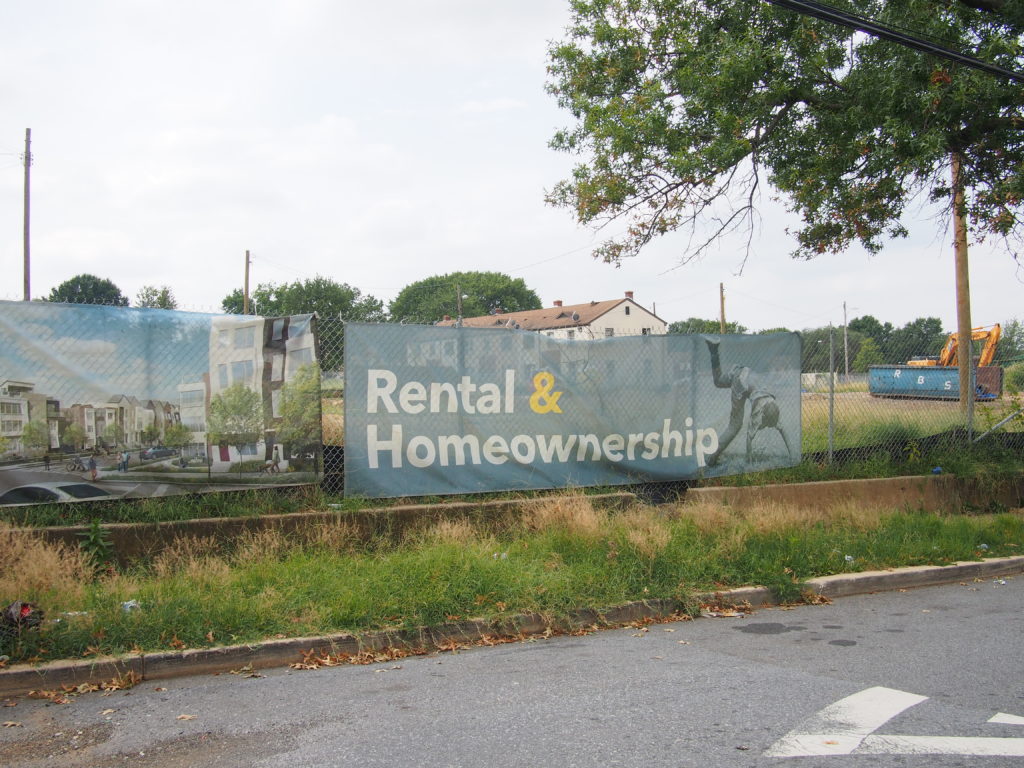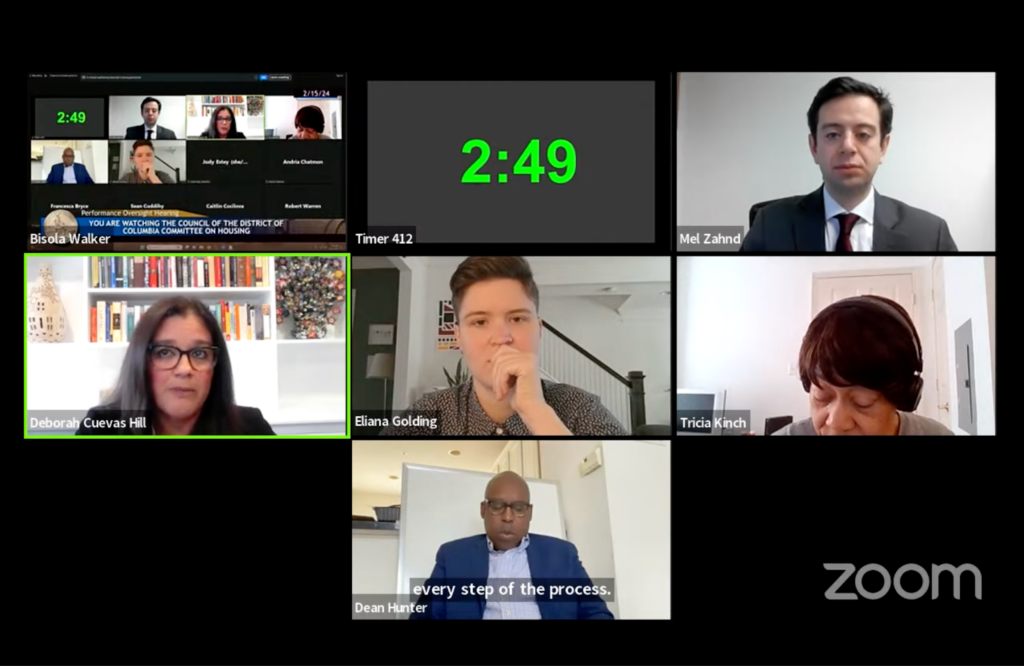On July 25, Community members from across the District filled the Historic Preservation Review Board (HPRB)’s courtroom, many wearing stickers that read, “Yes! Barry Farm is historic!” It was a hearing to consider historic designation for part of the Barry Farm public housing community and more than 20 people testified in favor of the historic designation.
The hearing date, originally scheduled for June 27, had been pushed back twice at the request of the D.C Housing Authority. A month later, at the July 25 hearing, the HPRB did not have a quorum and consequently could not conduct a final vote. A second hearing was scheduled for Aug. 1, but was pushed back until Sept. 26 at the request of the D.C. Housing Authority.
For former residents of the 442-unit public housing community, a historic designation would be confirmation of a truth they already know, according to Detrice Belt, chair of the Barry Farm Tenants and Allies Association.
“We have always believed our homes to be historic,” Belt said in the HPRB hearing. “Declaring Barry Farm as a historical landmark will ensure that our history will be remembered and our stories are told and that we will see our reflections in communities for years to come.”
The debated historic designation would include only the 32 remaining houses left post-demolition of Barry Farm Dwellings, according to the HPRB application. The buildings are located at 1100-1371 Stevens Road, 2677-2687 Wade Road, and 2652 Firth Sterling Avenue SE and represent roughly fifty percent of the original units of Barry Farm Dwellings before demolition.

The applicants argue that the houses show ample historical significance as they were established by the federal government for the purpose of providing African Americans affordable housing after the Civil War, and historically important figures resided in some of the homes.
The Historic Preservation Office, however, has recommended that the board not designate the remaining Barry Farm Dwellings as a historic site.
“The property no longer possesses sufficient integrity to convey, represent or contain the values and qualities for which it is judged significant,” the office said in a June 27 report. “Although the surviving buildings of Barry Farm Dwellings are directly associated with the development of public housing for African Americans during World War II … the buildings do not retain sufficient integrity to convey the values and qualities for which the property is judged significant.”
DCHA, along with the A&R companies and Preservation of Affordable Housing Inc., intends to turn the public housing community into a mixed-income area. The plan aims to increase the total number of units from 444 to 1100, while providing 380 units as public housing, according to the Barry Farm Redevelopment website. The project will also include approximately 40,000 square feet of retail space, a 2.4 acre park, and updates to infrastructure.
The plan calls for one-for-one replacement of the existing housing units to ensure there is no net loss of subsidized units, according to the NCI website.
The plan was stalled last year, however, when the D.C. Court of Appeals ruled in favor of the Tenants and Allies Association’s petition to reexamine the D.C. Zoning Commission’s decision to redevelop the Barry Farm neighborhood.
DCHA failed to present an updated plan in front of the HPRB.

[Read More: Residents stall redevelopment at Barry Farms]
There are currently no households remaining in Barry Farm. Demolition has begun and people have been relocated to other public housing or given Housing Choice vouchers to use elsewhere. In some instances residents have been relocated to smaller houses without the proper accommodations for storage, according to Belt, who now lives in an apartment.
“I used to be in a house,” Belt said in an interview with Street Sense Media. “Now, I have to have storage. They are offering us storage for one year, but that’s not enough.”
The community has been displaced throughout the city and are unable to keep in touch with each other, according to a former resident who lived in Barry Farm from approximately 1969 to 1981.
“It’s been years since I’ve seen [my friends], so everyone’s aged,” she said in an interview with Street Sense Media. “I have to try to reflect on how to approach [them] so they can remember who I am. You need to refresh their memory.”
Crime and homelessness has increased, according to Belt.
“We’re seeing more homelessness, we’re seeing more crime after Barry Farm started being demolished,” Belt said in an interview with Street Sense Media. “They blame Barry Farm for so much crime, so much negativity placed on our community. They say that we have a choice and we are guaranteed to come back, but we’ve seen at other properties that that has not happened.”

Barry Farm was first created out of a purchase by the Freedmen’s Bureau in 1867 as a 375-acre plot for refugees from slavery. Barry Farm Dwellings was officially turned into segregated public housing in 1941, according to the D.C. Policy Center.
Prominent political figures such as Charles Douglass and Solomon Brown lived in the neighborhood, as did Justice of the Peace John Moss and the assistant superintendent of D.C.’s African-American schools, Garnet Wilkinson. Civil rights leaders Lillian Wright and Ella Mae Horn, who later founded the National Welfare Rights Organization, also resided at Barry Farm.
Among other efforts to preserve the neighborhood, D.C. Public Library has partnered with the Anacostia Community Museum to bring the “A Right to the City” exhibition to neighborhood libraries across the District. As a part of the series, the Anacostia Neighborhood Library hosted an event in the Barry Farm area on Aug. 5 called, “Ten Strong: Women of Barry Farm/Hillsdale,” focusing on the impact 10 prominent female figures had in the Barry Farm area.
Alcione Amos, an Anacostia Community Museum curator, spoke as an expert witness at the July 25 hearing, telling those gathered in the classroom-like space that when Barry Farm was originally built, there were 359 one-acre lots throughout the area. Between 1867 and 1871, 47 women purchased lots and paid taxes on the property..
In the audience on July 25 were current and former Barry Farm residents, as well as people from across the city. One attendee, Tia Prue Fails, mentioned that her family had lived on Elvans Road for decades. For Amos, hosting informative events about D.C.’s history is crucial to help inspire affected residents.

“I want them to be very proud of their history, and the history that went on before them,” Amos said in an interview with Street Sense Media. “I think it’s very important for people to build their lives knowing that in the past there was a lot of excellence and a lot of great things happening in this community. I think it’s almost a duty of mine to enlighten people about the history of their community.”
Amos’ presentation described figures such as Georgiana Rose Simpson, who was the second African American woman to get a PhD in 1921; Frances Eliza Hall, a white woman who moved to Barry Farm at age 46 as the first teacher; and Emily Edmonton Johnson, one of the fugitives from the nonviolent slave escape of The Pearl.
Barry Farm residents were also involved in Bolling v. Sharpe, the landmark case that desegregated D.C. public schools, alongside Brown v. Board of Education in 1954. Amos will be presenting on the impacts civil rights activism held in the Barry Farm community at the Anacostia Neighborhood Library on Sept. 9.
At the July 25 hearing, personal testimonies from previous, current, and non-Barry Farm residents highlighted the impact the historical significance has had on community members.
Its multilayered history is one that many D.C. residents do not know of, according to Amber Wiley, assistant professor of art history at Rutgers University.
“Barry Farm represents some of the most powerful moments in national and local history,” Wiley said at the HPRB hearing. “The stories and lessons embodied in these buildings are lessons that current Washingtonians, old and new, need to know. They are all lessons central to an American history that has been obscured as of late.”
In other words, many youth growing up in the Barry Farm area do not have access to their history in schools, according to a Ward 8 resident.
“I feel as though there’s not enough tools that’s given to the youth in that neighborhood to know their background and to know how powerful they are coming from the Barry Farm area,” she said at the HPRB hearing.“When you have a sense of where your background is, it drives you to go further, it drives you to be proud of where you’re coming from and to represent your community. If you show the youth that their neighborhood means nothing, that means that they have nothing to fight for.”

Other testimony included community members who were surprised that they had not heard of the Barry Farm history in depth. Many emphasized the need to preserve Black history and contributions in D.C. The historic designation is more than just a debate about building integrity and repair, according to civil rights attorney Courtney Alexander.
“This is more than a cosmetic request,” Alexander said at the HPRB hearing. “The large outdoor community areas, the inclusion of spacious townhomes, and a strategic use of cross streets was intended to avoid blight, help families to remain physically and emotionally healthy, and encourage socialization between neighbors. The culture and significance of Barry Farm is inextricably intertwined with and as a consequence of those design elements. We cannot pretend that this is about buildings, bricks, stucco, or demolishing just another public housing site.”
Regardless of an unclear plan, however, DCHA plans on moving forward with redevelopment because the site is beyond repair, according to Christine Goodman, DCHA supervisory media relations specialist.
“We continue to be concerned about the hundreds of people who planned to return to the redeveloped site in 2020,” Goodman wrote in an email to Street Sense Media. “The physical condition of the buildings at Barry Farm make rehabilitation impossible, this is why DCHA is redeveloping the community so that the families can return to new homes as soon as possible.”
ANC 8C Commissioner Rhonda Edwards-Hines agrees that historic designation should be rejected because of the state of the buildings.
“I remember when I moved in Barry Farms in May of 1989,” Edwards-Hines wrote in a statement that was read on her behalf at the hearing. “I raised my children in this community – it’s home to us. Living in this community, I know first-hand the units are beyond repair. They are unhealthy, and with the decay of the units, it doesn’t allow for a healthier, safe neighborhood.”
While the next hearing is sscheduled for Sept. 26, the Tenants and Allies Association is willing to negotiate with the Housing Authority if some demands are met, according to Belt.
“We may back out of the historic preservation if they give us some of our demands — if they do agree to give us the museum and still make it so we can preserve it ourselves without going to the board,” Belt said in an interview with Street Sense Media. “It’s still in negotiations, we don’t think they will do that. We think that we will be going ahead with the vote to make it historic.”








